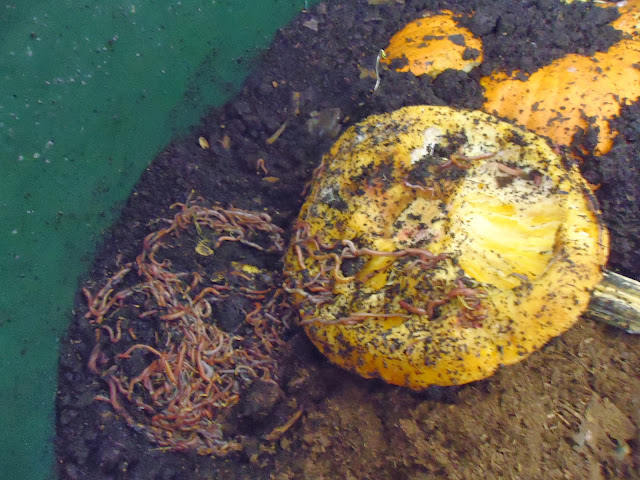Remember the pumpkin feast of 2012 and the funny mold?
Guess who's back:
Last year, I learned that this was likely sclerotinia sclerotiorum- not much to worry about in the bin, as the worms would eat it and poop it back out into the same great organic fertilizer they always do!
Turning over a pumpkin top in the bin can be an adventure...
Pretty slimy!
I pushed around a few pieces and uncovered more wormtastic wonderfulness:
The worms have a lot of work left to do...I have four smaller pumpkins waiting in the wings as dessert!
Speaking of teamwork and wings...Happy Veterans Day and thank you to all who have served or are currently serving in our military!
"the most nonspecific, omnivorous, and successful of
plant pathogens"- according to a reference compiled from the University of Hawaii. - See more at: http://lilliworm.blogspot.com/2012/11/pictures-to-make-you-squirm.html#sthash.gghc71SO.dpuf
I've never seen this type of mold before in my bin, but a quick Google search told me it's probably sclerotinia sclerotiorum, "the most nonspecific, omnivorous, and successful of
plant pathogens"- according to a reference compiled from the University of Hawaii.
There is plenty of time for the worms to gobble that up and push it out before planting season next year, which is good because I don't need any omnivorous pathogens making my organic gardening life any more difficult.
That's the great thing about worms- they are able to take all sorts of disgusting, moldy, rotting things and turn them into fantastic organic plant food. In Australia, there are even giant industrial worm farms designed to process sewage and water waste. You can read a great set of FAQs about these systems at A&A Wormfarm Waste Systems. - See more at: http://lilliworm.blogspot.com/2012/11/pictures-to-make-you-squirm.html#sthash.gghc71SO.dpuf
There is plenty of time for the worms to gobble that up and push it out before planting season next year, which is good because I don't need any omnivorous pathogens making my organic gardening life any more difficult.
That's the great thing about worms- they are able to take all sorts of disgusting, moldy, rotting things and turn them into fantastic organic plant food. In Australia, there are even giant industrial worm farms designed to process sewage and water waste. You can read a great set of FAQs about these systems at A&A Wormfarm Waste Systems. - See more at: http://lilliworm.blogspot.com/2012/11/pictures-to-make-you-squirm.html#sthash.gghc71SO.dpuf
I've never seen this type of mold before in my bin, but a quick Google search told me it's probably sclerotinia sclerotiorum, "the most nonspecific, omnivorous, and successful of
plant pathogens"- according to a reference compiled from the University of Hawaii.
There is plenty of time for the worms to gobble that up and push it out before planting season next year, which is good because I don't need any omnivorous pathogens making my organic gardening life any more difficult.
That's the great thing about worms- they are able to take all sorts of disgusting, moldy, rotting things and turn them into fantastic organic plant food. In Australia, there are even giant industrial worm farms designed to process sewage and water waste. You can read a great set of FAQs about these systems at A&A Wormfarm Waste Systems. - See more at: http://lilliworm.blogspot.com/2012/11/pictures-to-make-you-squirm.html#sthash.gghc71SO.dpuf
There is plenty of time for the worms to gobble that up and push it out before planting season next year, which is good because I don't need any omnivorous pathogens making my organic gardening life any more difficult.
That's the great thing about worms- they are able to take all sorts of disgusting, moldy, rotting things and turn them into fantastic organic plant food. In Australia, there are even giant industrial worm farms designed to process sewage and water waste. You can read a great set of FAQs about these systems at A&A Wormfarm Waste Systems. - See more at: http://lilliworm.blogspot.com/2012/11/pictures-to-make-you-squirm.html#sthash.gghc71SO.dpuf
I've never seen this type of mold before in my bin, but a quick Google search told me it's probably sclerotinia sclerotiorum, "the most nonspecific, omnivorous, and successful of
plant pathogens"- according to a reference compiled from the University of Hawaii.
There is plenty of time for the worms to gobble that up and push it out before planting season next year, which is good because I don't need any omnivorous pathogens making my organic gardening life any more difficult.
That's the great thing about worms- they are able to take all sorts of disgusting, moldy, rotting things and turn them into fantastic organic plant food. In Australia, there are even giant industrial worm farms designed to process sewage and water waste. You can read a great set of FAQs about these systems at A&A Wormfarm Waste Systems. - See more at: http://lilliworm.blogspot.com/2012/11/pictures-to-make-you-squirm.html#sthash.gghc71SO.dpuf
There is plenty of time for the worms to gobble that up and push it out before planting season next year, which is good because I don't need any omnivorous pathogens making my organic gardening life any more difficult.
That's the great thing about worms- they are able to take all sorts of disgusting, moldy, rotting things and turn them into fantastic organic plant food. In Australia, there are even giant industrial worm farms designed to process sewage and water waste. You can read a great set of FAQs about these systems at A&A Wormfarm Waste Systems. - See more at: http://lilliworm.blogspot.com/2012/11/pictures-to-make-you-squirm.html#sthash.gghc71SO.dpuf










No comments:
Post a Comment